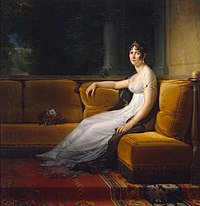Some background:
I worked in the costume shop during my four years in college. I helped with the costume design for a handful of shows. I also know a little about period costume/fashion (but not a great deal).
Billie Piper as Fanny Price:

ALSO - I must confess I haven't read Mansfield Park by Jane Austen. It's on my list!
So I can't give a detailed analysis of Fanny Price's character. I can't say if she's supposed to be a rebel - wild and free. If indeed she is a character who is supposed to buck convention, then perhaps the hairstyle in the latest version of
Mansfield Park (recently on pbs' Masterpiece Theatre) makes sense.
There isn't a scene in the entire adaptation (including her wedding) where Fanny has her hair up in the classic regency hairdo.
Her hair hangs in disheveled curls - not even in tight curls that were sort of fashionable near the end of the regency period.
The classic hairdo from that period?
Think Gyneth Paltrow's hair in 1996's "Emma":

- or paintings of Josephine from the Napoleonic period.

Should period films be required to stick close to the original fashions? Can they make changes? What do those changes mean? Do they date the films/shows to the current time period?
Obviously, not everything is possible. Human bodies have grown and changed since that time (we're taller on average with broader shoulders). And to our eyes, some fashion seems odd (think men in corsets in the 1830s). But it would be odd to have a period film from the eighteenth century without women corsets, for example. Or colors - does it make sense to stick with a palette from the time or to add colors - red, green, purple etc. For some characters – access to dye or dyed fabric would have been out of their means.
Some of this may be just part of the art of the film.
But some of these "anachronisms" may not give the true feel of the original book or time period. Speaking of corsets, to have a lead actress not wear a corset (in a play set in the nineteenth century) would be disingenuous. Socially, the character would be almost outside society - it would be (for us) like someone going without shoes or without a shirt.
To give another example (and book I haven't read either) - in the latest (again Masterpiece Theatre) adaptation of Jane Eyre, Jane's character has her hair up throughout the film. Except from the brief scene when she's wandering on the moor - desolate. It gives added value to just how despondent she was - that she couldn't even work with her own hair.

All in all, I know that most films miss the complexity of their original books. So few films actually do their original books justice. These films (where I haven't read the originals) seem to be good though - and peak my interest.
I have enjoyed the series (I like pbs shows in general) and feel they're well done. As far as "Mansfield Park" goes - I enjoyed it, I just disagree with some of the makeup/design elements for Fanny.

3 comments:
I'm so glad to have another reason to be irked by this Mansfield Park (one of my favorite Austen novels). I was mostly irritated by the dialogue--Jane Austen wrote such good lines for her characters, and it seems like this screenplay didn't use any of them (though I haven't read the book in a long time and I didn't make it all the way through the TV showing).
Ack--hit enter by accident! Anyway, Fanny is supposed to be very shy and retiring and timid--I can't imagine that she would have worn her hair other than in the conventional fashion (although on the low end of the conventional fashion, to be sure).
Thanks Laura! It doesn't make any sense why they wouldn't base the adaptation on the diologue from the book...obviously, all the dialogue doesn't translate well to a screenplay, but some should...
Thanks for the thoughts on Fanny. I will have to read Mansfield Park at some point. The Jane Austen society of NA has a contest for essays about the films, btw. You should enter!
Post a Comment